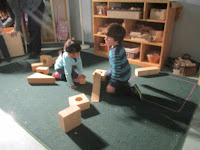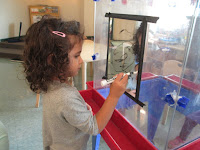Week In Review: October 19th- 23rd
Exploring the leaves through painting
Since the beginning
of the semester, the children have been exploring lines, shapes and contours
within nature. This week, we focused on representing the leaves with tempra
paint. Before we began painting we talked about the shape, color and size of the
leaves. Some children explored the leaves by tracing the outside of them with
their finger. Other children focused on the shape and color of the leaf.
We provoked the children with red, orange, green and yellow paints. We talked
about the colors we were going to use to represent the leaves. Some children
pointed out that multiple colors make up the composition of the leaf;
therefore, they used more than one color to represent the leaf.


Early Childhood Standards of Quality Met:
3. Early Learning Expectation: Knowledge about the Earth. Children show a beginning awareness of scientific knowledge related to the earth.
6. Early Learning Expectation: Fine Motor Development. Children
experience growth in fine motor development and use small
muscles to improve a variety of fine motor skills both in structured
and unstructured settings.
Collaborative Art Project
We offered the
children wire and beads to work with last week. We observed them threading the
beads on carefully and focusing on how to add new beads to their wire. This
widespread interest made us wonder how we could use the beads to let each child
express themselves further. We provoked the children with wire and
offered them a variety of different beads. We asked them to be purposeful about the
beads they chose before we added them to the wire. We talked about the different
shapes, textures, and colors that made up the beads. These individual bead designs
will be hung up to add another creative element to our classroom environment.
Early Childhood Standards of Quality Met:
3. Early Learning Expectation: Classification and Patterns. Children begin to develop skills of recognizing, comparing and classifying objects, relationships, events and patterns in their environment and in everyday life.
4. Early Learning Expectation: Counting and Cardinality. Children extend their understanding of numbers and their relationship to one another and things in the environment.
5. Early Learning Expectation: Aesthetic Appreciation. Children develop rich and rewarding aesthetic lives.
6. Early Learning Expectation: Fine Motor Development. Children experience growth in fine motor development and use small muscles to improve a variety of fine motor skills both in structured and unstructured settings.
Creating a Pathway
 The children have
been following this idea of creating different pathways. We are trying to think
of new ways to help them expand on their play. We noticed them trying to create
turns in their paths, but the pathway materials such as PVC pipes, cardboard
tubes, and ramps were all straight. We decided to try connecting marble mazes.
We noticed the children interested in the different lines, curves, shapes, and
turns the marble mazes had to offer. While creating different pathways, they
engaged their problem solving skills by figuring out how to get the marble all
the way down their path. We saw some children learning to work together and
collaborate on their pathways.
The children have
been following this idea of creating different pathways. We are trying to think
of new ways to help them expand on their play. We noticed them trying to create
turns in their paths, but the pathway materials such as PVC pipes, cardboard
tubes, and ramps were all straight. We decided to try connecting marble mazes.
We noticed the children interested in the different lines, curves, shapes, and
turns the marble mazes had to offer. While creating different pathways, they
engaged their problem solving skills by figuring out how to get the marble all
the way down their path. We saw some children learning to work together and
collaborate on their pathways.
Early Childhood Standards of Quality Met:
1. Early Learning Expectation: Creativity-Imagination-Visualization.
Children demonstrate a growing ability to use originality or vision
when approaching learning; use imagination, show ability to
visualize a solution or new concept.
2. Early Learning Expectation: Initiative-Engagement-Persistence Attentiveness.
Children demonstrate the quality of showing
interest in learning; pursue learning independently.
5. Early Learning Expectation: Reasoning-Problem Solving-Reflection.
Children demonstrate a growing capacity to make meaning, using
one’s habits of mind to find a solution or figure something out.





































